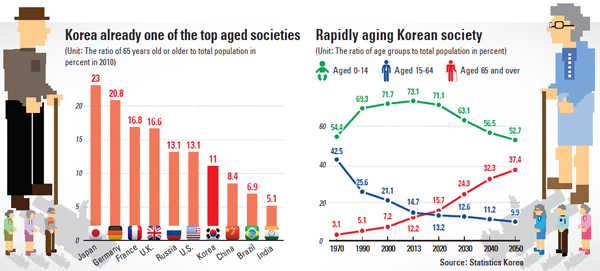Seniors pass 6 million

This is the first time the age group exceeded 6 million people.
Furthermore, the percentage of the population 65 and older has increased 3.9 percentage points compared with 10 years ago.
Statistics Korea projected that by 2030, one out of four people will be in that age group, while by 2050, Korea will among the oldest societies in the world with 37 percent of its population 65 years old or more.
The report released by the statistics office yesterday again quantified the rapidly aging population. The aging population has been one of the biggest concerns for the world’s 15th largest economy as it signifies that the number of people actively participating in the nation’s economy is shrinking significantly.
In addition, it means the financial burden will further increase for younger people responsible for supporting senior citizens through programs such as state-managed health insurance.
An aging society is defined as one where 7 percent to 14 percent of its population is 65 years or older. Korea first entered this category in 2000.
The statistics office projected that Korea will likely move up to the next level, that of an aged society, in 2017. Aged societies are those where 14 percent to 20 percent of the population is 65 years or older.
The rate of aging is expected to accelerate significantly compared to other advanced economies or the BRIC (Brazil, Russia, India and China) economies.
According to the UN’s “World Population Prospects” report released last year, Korea’s elderly represented 11 percent of the population as of 2010 compared with Japan’s 23 percent or Germany’s 20 percent.
It is one notch below the U.S. rate of 13 percent. But in 2040, Korea is expected to climb up the ranks 32.3 percent, ahead of Germany (31.8 percent) and behind Japan (34.5 percent).
The statistics office added that the burden of supporting older citizens is expected to grow. Currently, there are six people aged 15 to 64 supporting one senior citizen. That number is expected to shrink to five in 2018 and 1.4 in 2050.
The shrinking number is a result of the country’s low birthrate.
“In 2017, the elderly population will exceed the population of those 14 years old or younger,” said Statistics Korea. “By 2020, the burden in supporting the elderly will be the same as Germany’s, and just below Japan’s.”
Last year, the cost of medical treatment for persons aged 65 and older through the nation’s health insurance plan was 16 trillion won ($14.9 billion), which accounted for one-third of all medical spending.
Meanwhile, the share of older people able to continue to work grew to 30.7 percent last year from 29.5 percent in 2011.
By LEE HO-JEONG [ojlee82@joongang.co.kr]










with the Korea JoongAng Daily
To write comments, please log in to one of the accounts.
Standards Board Policy (0/250자)